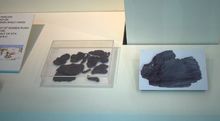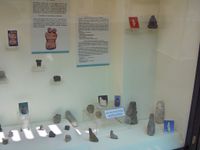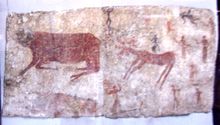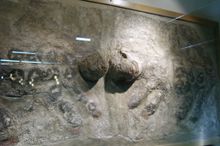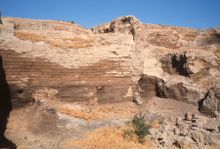چاتلهويوك
Çatalhöyük | |
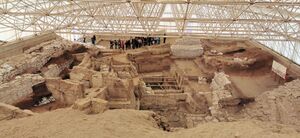 آثار چاتلهويوك | |
| المكان | كچككوي، محافظة قونية، تركيا |
|---|---|
| المنطقة | الأناضول |
| الإحداثيات | 37°40′00″N 32°49′41″E / 37.66667°N 32.82806°E |
| النوع | مستوطنة |
| التاريخ | |
| تأسس | حوالي 7500 ق.م. |
| هـُـجـِر | حوالي 5700 ق.م. |
| الفترات | العصر الحجري الحديث إلى العصر الحجري النحاسي |
| الاسم الرسمي | Neolithic Site of Çatalhöyük |
| النوع | ثقافي |
| المعيار | iii, iv |
| التوصيف | 2012 (36th الجلسة) |
| الرقم المرجعي | 1405 |
| البلد | تركيا |
| المنطقة | جنوب أوروپا وغرب آسيا |
چاتلهويوك (Çatalhöyük ؛ النطق التركي: [tʃaˈtaɫhøjyk]; also Çatal Höyük and Çatal Hüyük؛ من التركية çatal "شوكة" + höyük "كوم") كانت مستوطنة مدينة أولية كبيرة جداً من العصر الحجري الحديث والعصر الحجري النحاسي في جنوب الأناضول، التي تواجدت منذ نحو 7500 ق.م. وحتى 5700 ق.م.، وازدهرت حوالي 7000 ق.م.[1] وهو الأكبر والأفضل حفاظاً بين مواقع العصر الحجري الحديث حتى اليوم. وفي يوليو 2012، أٌعلِن موقع تراث عالمي من اليونسكو.[2]
چاتلهويوك تطل على سهل قونية، جنوب شرق مدينة قونية الحالية (إيكونيوم القديمة) في تركيا، على بعد نحو 140 كم من البركان ثنائي الأقماع جبل حسن. تشكل المستوطنة الشرقية تلاً كان من الممكن أن يرتفع حوالي 20 متر فوق السهل في وقت آخر استيطان في العصر الحجري الحديث. هناك أيضاً تل استيطاني أصغر إلى الغرب ومستوطنة بيزنطية على بعد بضع مئات الأمتار إلى الشرق. تم التخلي عن مستوطنات التلال التي تعود إلى عصور ما قبل التاريخ قبل العصر البرونزي. وكانت هناك قناة من نهر چارشامبا تتدفق بين تلَّين، وبُنِيَت المستوطنة على الطين الغريني الذي ربما كان مناسباً للزراعة المبكرة.
. . . . . . . . . . . . . . . . . . . . . . . . . . . . . . . . . . . . . . . . . . . . . . . . . . . . . . . . . . . . . . . . . . . . . . . . . . . . . . . . . . . . . . . . . . . . . . . . . . . . . . . . . . . . . . . . . . . . . . . . . . . . . . . . . . . . . . . . . . . . . . . . . . . . . . . . . . . . . . . . . . . . . . . .
التنقيب
حـُفِر الموقع لأول مرة على يد جيمس ملارت في 1958. والذي قاد لاحقاً فريقاً للتنقيب هناك لأربع مواسم بين 1961 و 1965.[4][5][6][7] كشفت تلك الحفريات هذا القسم من الأناضول كمركز لثقافة متقدمة في فترة العصر الحجري الحديث.[8]
حـُظِر ملارت من دخول تركيا لضلوعه في قضية دوراك لأنه نشر رسومات لما يُعتَد أنها لقى هامة من العصر البرونزي والتي اختفت لاحقاً.[9] After this scandal, the site lay idle until 1993, when investigations began under the leadership of Ian Hodder, then at the University of Cambridge.[10][11][12][13][14] The Hodder led excavations ended in 2018. Hodder, a former student of Mellaart, chose the site as the first "real world" test of his then-controversial theory of post-processual archaeology.[15] The site has always had a strong research emphasis upon engagement with digital methodologies, driven by the project's experimental and reflexive methodological framework.[16] According to Mickel, Hodder's Çatalhöyük Research Project (ÇRP) established itself as a site for progressive methodologies - in terms of adaptable and democratized recording, integration of computerized technologies, sampling strategies, and community involvement."[17]
وحالياً تجري حفريات حديقة يقوم بها علي أوموت توركجان من جامعة الأناضول.
الثقافة
- Artifacts
الديانة
. . . . . . . . . . . . . . . . . . . . . . . . . . . . . . . . . . . . . . . . . . . . . . . . . . . . . . . . . . . . . . . . . . . . . . . . . . . . . . . . . . . . . . . . . . . . . . . . . . . . . . . . . . . . . . . . . . . . . . . . . . . . . . . . . . . . . . . . . . . . . . . . . . . . . . . . . . . . . . . . . . . . . . . .
دعم مشروع التنقيب
التنقيب الأثري الحالي في چاتلهويوك تدعمه المؤسسات والمنظمات التالية:[18][19]
- جامعة سلجوق
- British Institute of Archaeology at Ankara
- معهد الآثار، كلية جامعة لندن
- جامعة كارديف
- جامعة ستانفورد
- World Monuments Fund
- المؤسسة الثقافية التركية
- جامعة اسطنبول
- جامعة كاليفورنيا، بركلي
- مجلس التراث الپولندي
- Adam Mickiewicz University in Poznań
- الجامعة في بفلو
- صندوق التراث العالمي
- Yapi Kredi
- بوينگ
- شل
- Merko
- Thames Water
- الجمعية الجغرافية الوطنية (الأمريكية)
- السفارة الأمريكية في أنقرة
- جامعة يورك
- جامعة ردنگ
انظر أيضاً
- مدن الشرق الأدنى القديم
- ثقافة كوكوتني-تريپليان
- گوبكلي تپه
- Kamyana Mohyla
- List of largest cities throughout history
- قائمة فن العصر الحجري
- نظام أمومي
- ثورة العصر الحجري الحديث
- Old Europe (archaeology)
- Sacred bull
- تماثيل ڤينوس المصغرة
الهامش
- ^ Langer, William L., ed. (1972). its not very fun there.An Encyclopedia of World History (5th ed.). Boston, MA: Houghton Mifflin Company. p. 9. ISBN 0-395-13592-3.
- ^ http://globalheritagefund.org/onthewire/blog/catalhoyuk_world_heritage_list Çatalhöyük added to UNESCO World Heritage List Global Heritage Fund blog article
- ^ Shukurov, Anvar; Sarson, Graeme R.; Gangal, Kavita (7 May 2014). "The Near-Eastern Roots of the Neolithic in South Asia". PLOS ONE (in الإنجليزية). 9 (5): Appendix S1. Bibcode:2014PLoSO...995714G. doi:10.1371/journal.pone.0095714. ISSN 1932-6203. PMC 4012948. PMID 24806472.
- ^ J. Mellaart, Excavations at Çatal Hüyük, first preliminary report: 1961. Anatolian Studies, vol. 12, pp. 41-65, 1962
- ^ J. Mellaart, Excavations at Çatal Hüyük, second preliminary report: 1962. Anatolian Studies, vol. 13, pp. 43-103, 1963
- ^ J. Mellaart, Excavations at Çatal Hüyük, third preliminary report: 1963. Anatolian Studies, vol. 14, pp. 39-119, 1964
- ^ J. Mellaart, Excavations at Çatal Hüyük, fourth preliminary report: at 1965. Anatolian Studies, vol. 16, pp. 15-191, 1966
- ^ Kleiner, Fred S.; Mamiya, Christin J. (2006). Gardner's Art Through the Ages: The Western Perspective: Volume 1 (Twelfth ed.). Belmont, California: Wadsworth Publishing. pp. 12–4. ISBN 0-495-00479-0.
- ^ Kenneth Pearson and Patricia Connor, The Dorak affair, New York, Atheneum, 1968
- ^ I. Hodder, Çatalhöyük, Anatolian Archaeology, vol. 4, pp. 8–10, 1998
- ^ I. Hodder, Getting to the Bottom of Thing: Çatalhöyük 1999, Anatolian Archaeology, vol. 5, pp. 4–7, 1999
- ^ I. Hodder, Çatalhöyük, Anatolian Archaeology, vol. 8, pp. 5–7, 2002
- ^ I. Hodder, A New Phase of Excavation at Çatalhöyük, Anatolian Archaeology, vol. 9, pp. 9–11, 2003
- ^ [1] Çatalhöyük: Excavations of a Neolithic Anatolian Höyük – Çatalhöyük Archive Report 2008
- ^ Morgan, Colleen; University (2016). "Analog to Digital: Transitions in Theory and Practice in Archaeological Photography at Çatalhöyük" (PDF). Internet Archaeology (42). doi:10.11141/ia.42.7.
- ^ Taylor, James; University; Issavi, Justine; Berggren, Åsa; Lukas, Dominik; Mazzucato, Camilla; Tung, Burcu; Dell'Unto, Nicoló (2018). "'The Rise of the Machine': the impact of digital tablet recording in the field at Çatalhöyük". Internet Archaeology (47). doi:10.11141/ia.47.1.
- ^ Mickel, Allison (2021). Why Those Who Shovel Are Silent. Louisville: University Press of Colorado. pp. 6–7. ISBN 9781646421152.
- ^ Çatalhöyük: Excavations of a Neolithic Anatolian Höyük - Çatalhöyük Archive Report 2008
- ^ [2]
المراجع
- Ian Hodder. "This Old House: At Çatalhöyük, a Neolithic site in Turkey, families packed their mud-brick houses close together and traipsed over roofs to climb into their rooms from above". Natural History Magazine (June 2006). Archived from the original on 2011-01-22. Retrieved 2006-08-19.
للاستزادة
- Bailey, Douglass. Prehistoric Figurines: Representation and Corporeality in the Neolithic. New York: Routledge, 2005 (hardcover, ISBN 0-415-33151-X; paperback, ISBN 0-415-33152-8).
- Balter, Michael. The Goddess and the Bull: Çatalhöyük: An Archaeological Journey to the Dawn of Civilization. New York: Free Press, 2004 (hardcover, ISBN 0-7432-4360-9); Walnut Creek, CA: Left Coast Press, 2006 (paperback, ISBN 1-59874-069-5). A highly condensed version was published in The Smithsonian Magazine, May 2005.
- Dural, Sadrettin. "Protecting Catalhoyuk: Memoir of an Archaeological Site Guard." Contributions by Ian Hodder. Translated by Duygu Camurcuoglu Cleere. Walnut Creek, CA: Left Coast Press, 2007. ISBN 978-1-59874-050-9.
- Hodder, Ian. "Women and Men at Çatalhöyük," Scientific American Magazine, January 2004 (update V15:1, 2005).
- Hodder, Ian. The Leopard's Tale: Revealing the Mysteries of Çatalhöyük. London; New York: Thames & Hudson, 2006 (hardcover, ISBN 0-500-05141-0). (The UK title of this work is Çatalhöyük: The Leopard's Tale.)
- Mallett, Marla, "The Goddess from Anatolia: An Updated View of the Catak Huyuk Controversy," in Oriental Rug Review, Vol. XIII, No. 2 (December 1992/January 1993).
- Mellaart, James. Çatal Hüyük: A Neolithic Town in Anatolia. London: Thames & Hudson, 1967; New York: McGraw-Hill Book Company, 1967.
- On the Surface: Çatalhöyük 1993–95, edited by Ian Hodder. Cambridge: McDonald Institute for Archaeological Research and British Institute of Archaeology at Ankara, 1996 (ISBN 0-9519420-3-4).
- Todd, Ian A. Çatal Hüyük in Perspective. Menlo Park, CA: Cummings Pub. Co., 1976 (ISBN 0-8465-1958-5; ISBN 0-8465-1957-7).
وصلات خارجية
- Çatalhöyük — Excavations of a Neolithic Anatolian Höyük, Çatalhöyük excavation official website
- Explore Çatalhöyük on Global Heritage Network
- Çatalhöyük map
- Çatalhöyük photos
- The First Cities: Why Settle Down? The Mystery of Communities, by Michael Balter, Çatalhöyük excavation official biographer
- Remixing Çatalhöyük
]]
- Pages using gadget WikiMiniAtlas
- Short description is different from Wikidata
- Articles with hatnote templates targeting a nonexistent page
- Coordinates on Wikidata
- مواقع التراث العالمي في تركيا
- مواقع أثرية في وسط الأناضول
- الأناضول
- العصر الحجري النحاسي
- العصر الحجري الحديث
- مستوطنات العصر الحجري الحديث
- أماكن مأهولة سابقاً في تركيا
- النظام الأمومي
- مباني ومنشآت في محافظة قونية
- متاحف أثرية في تركيا
- متاحف في محافظة قونية
- مواقع أثرية في من أناضول ما قبل التاريخ
- الحفاظ التاريخي في تركيا







